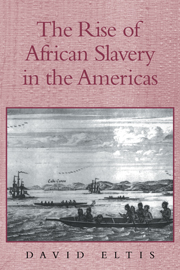Book contents
- Frontmatter
- Contents
- List of Tables
- List of Maps
- Preface
- Abbreviations
- Chapter 1 Slavery and Freedom in the Early Modern World
- Chapter 2 The English, the Dutch, and Transoceanic Migration
- Chapter 3 Europeans and African Slavery in the Americas
- Chapter 4 Gender and Slavery in the Early Modern Atlantic World
- Chapter 5 Productivity in the Slave Trade
- Chapter 6 Africa and Europe in the Early Modern Era
- Chapter 7 The African Impact on the Transatlantic Slave Trade
- Chapter 8 The English Plantation Americas in Comparative Perspective
- Chapter 9 Ethnicity in the Early Modern Atlantic World
- Chapter 10 Europe and the Atlantic Slave Systems
- Epilogue on Abolition
- Appendices
- Maps
- Sources and Bibliography
- Index
Chapter 1 - Slavery and Freedom in the Early Modern World
Published online by Cambridge University Press: 05 August 2012
- Frontmatter
- Contents
- List of Tables
- List of Maps
- Preface
- Abbreviations
- Chapter 1 Slavery and Freedom in the Early Modern World
- Chapter 2 The English, the Dutch, and Transoceanic Migration
- Chapter 3 Europeans and African Slavery in the Americas
- Chapter 4 Gender and Slavery in the Early Modern Atlantic World
- Chapter 5 Productivity in the Slave Trade
- Chapter 6 Africa and Europe in the Early Modern Era
- Chapter 7 The African Impact on the Transatlantic Slave Trade
- Chapter 8 The English Plantation Americas in Comparative Perspective
- Chapter 9 Ethnicity in the Early Modern Atlantic World
- Chapter 10 Europe and the Atlantic Slave Systems
- Epilogue on Abolition
- Appendices
- Maps
- Sources and Bibliography
- Index
Summary
By 1700, the two European nations generally regarded as having the most advanced capitalist culture, England and the Netherlands, had moved further away than any country in Europe from subjecting their citizens to overtly forced labor. Slave ships brought the occasional slave back to England and advertisements offering slaves for sale were seen in Liverpool and Bristol newspapers. It is nevertheless inconceivable that London, Liverpool, Nantes, or Amsterdam could have received complete cargoes of Africans on slave ships to be sold in public markets, as Lisbon and Cadiz did throughout the eighteenth century. Yet these northern European cities were in countries with the harshest and most closed systems of exploiting enslaved non-Europeans in the Americas. Further, England and the Netherlands came to dominate Europe's relations with the rest of the world: the Dutch specializing in Asia, and the English in the Americas.
The contrast between Europe's social institutions and values at home and their counterparts in European-controlled overseas territories became acute in the seventeenth century and forms the focus of the present work. The major issues are simply stated. First, why would Europeans revive slavery at the time of Columbian contact, when the institution had disappeared from large parts of Europe, and then, three centuries later, begin to suppress it? Second, why would that slavery be located almost exclusively in the Americas? Third, why would the slaves in this system be exclusively of non-European descent?
- Type
- Chapter
- Information
- The Rise of African Slavery in the Americas , pp. 1 - 28Publisher: Cambridge University PressPrint publication year: 1999
- 1
- Cited by



